
Esame ad un Giovane Ebreo Istruito Nella Sua Religione [Examination of a Jewish youth educated in his religion], by Simone Calimani (Simcha Kalimani). Trieste, 1784. Italian and a some Hebrew.
An essay on the Jewish religion, built in the format of questions and answers. The author, Rabbi Simcha Kalimani (1699-1781), playwright and poet, researcher of the Hebrew language, taught in the Talmud Torah of the Jewish community in Venice. The book is structured in the form of a question and answer from Rabbi to pupil and deals with the basics of faith: the existence of the Creator, divine providence, reward and punishment, the Olam HaBa, 613 mitzvot, prayer, Taamei HaMitzvot, and more.
Extremely Rare. This edition does not appear in the world library catalog world cat. Only two editions of the book are listed there. One, from 1786, and the other from 1787.
123, [1] p, 17 cm. Light stains and wrinkles. The second page is half missing. Antique drawings. Used cover. Former library copy. Condition Good-Moderate

Sefer Rishon LeMikraei Kodesh or ELEMENTS OF THE HEBREW LANGUAGE - an extensive Hebrew vocabulary for schools - an early book for learning the Hebrew language by Hyman Hurwitz, London 1807 - first edition. Hebrew and English. From the early books on the Hebrew language published in London.
A long introduction in which the author explains the importance of knowing the Hebrew language
[3] 140, XX p. Leather Spine. Markings and pencil notes on some pages of the book. Stains. Good Condition.

Professione di fede con domande e risposte ad uso della Gioventù Israelitica - "The Profession of Faith", with questions and answers for the children of Israel. Published by Joab Fano. Printed by Giuseppe Molinari. A rare essay by Joab Fano to teach the children of Israel when they reach the age of Bar Mitzvah the basics of the Jewish faith. Venice, 1827 - Only Edition. Italian and Hebrew page to page.
In the introduction, the author writes that he has written a short composition for the children of Israel who, when they reach the age of Mitzvahs, as they come to synagogue will sit before the rabbi for a "fundamental test", and he will ask them in the order of the questions presented here, which are built on the Rambam's Thirteen Principles of Jewish Faith, and the basic fundamentals of the Jewish religion - belief in one G-d, Moses his prophet, and in all that is written in the Holy Scriptures, observance of the 613 Mitzvot, belief in the resurrection of the dead, and the Olam HaBa. The book is written in easy language to be understandable for children. It is rare to find such Hebrew works in the 19th century.
The title page contains an illustration of Jerusalem and the site of the Temple, based on engravings that appeared in 17th-century travel books. At the end of the book is a certificate for a student who has completed the study of the principles of the Jewish religion (the student's details have been added in handwriting), hand signed by Rabbi Foa.
Extremely Rare. Only three entries in the World Cat library catalog.
29, [2] p, 18 cm. Stains. Minor tears on the page before the title page. No outer jacket. Good Condition. Former library copy.
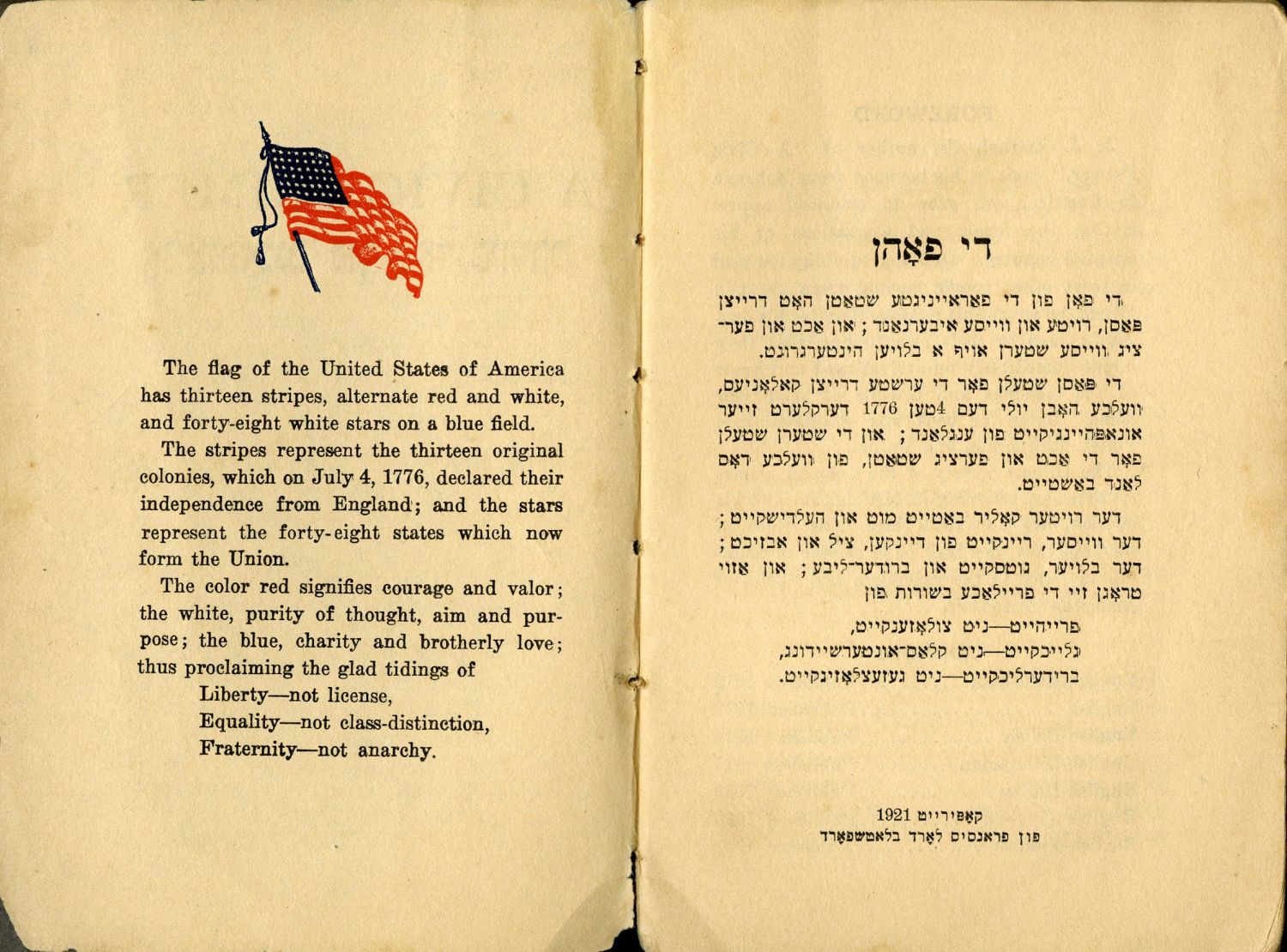
A civic primer : אנ׳אנפאנגס־בוך פאר סיוויקס - an introductory book to citizenship by J.J. Zmrhal, director of the "Theodore Herzl" school in Chicago. Published by the Illinois Society of the Colonial Dames of America. Chicago 1921, English and Yiddish page by page.
A detailed publication dealing with the study of the basic laws of the American citizen. Written for the students of the "Theodore Herzl" Jewish School in Chicago. The book details how one gets to obtain American citizenship, the citizen's duties and rights, the way of voting to elect the president, the structure of the various government ministries, the powers of the Supreme Court, the various taxes and the punishments for tax evaders, how the health services work in America, a summary of American history - "The Colonial Revolution", the American Civil War, the American War of Independence, and more. The book was written in a spirit that glorifies the American nation and its achievements and calls on the Hebrew citizen to take an active part in the effort for America which is an inseparable part of it.
60 p. Stained cover. Tears and open tears on the spine. Light stains on the title page. The body of the book is in Good Condition.

THE JEWISH SCHOOL FROM THE EARLIEST TIMES TO THE YEAR 500 OF THE PRESENT ERA - by Nathan Morris, published by Eyre and Spottiswoode, London 1937 - first edition. Hardcover with the original dust jacket. English.
The first systematic research of its kind dealing with the development of the Jewish education system, an in-depth analysis of the form and content of early Jewish education, as well as its religious and social background. The book deals with the beginnings of formal education among the Jews - the organization and equipment and internal arrangements of the elementary school, the scope of studies and the attitude to secular professions, the psychology behind Jewish education, the methods of teaching and discipline adopted in Jewish educational institutions, the Jewish view on manual labor and its place in the curriculum, and more. The author also studied Jewish education in relation to the parallel currents in general education, and emphasized the mutual influences. One of the chapters in the book deals with the legal status of the Jewish woman, as well as the place of Hebrew language in Jewish education in the 20th century.
XXVII, 277 p. 23 cm. Hard cover, original, with the original dust jacket. Tears at the top and bottom of the dust jacket. Good Condition.
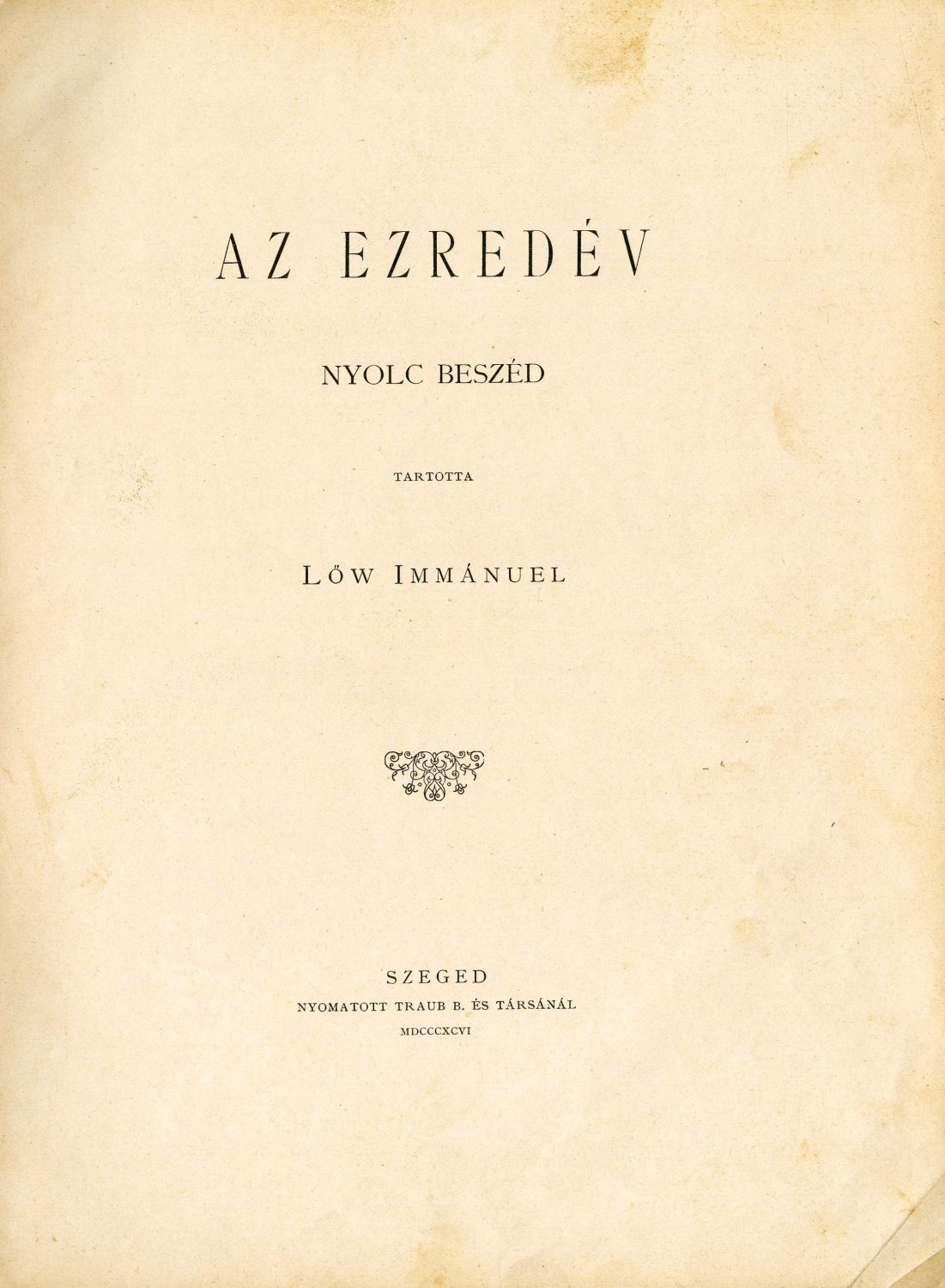
AZ EZREDEV NYOLC BESZED TARTOTTA LOW IMMANUEL - "The Millennium" - a collection of Drashot delivered by Rabbi Drashot Low as part of the events of the Hungarian Millennium celebrations - Szeged (Hungary) 1896 - Only Edition. Printed on thick and magnificent paper, text in the center of the page with extra wide margins.
Eight Drashot delivered by Rabbi Low in May-June 1896 on the occasion of the Hungarian millennium. Drashot on the virtue of Eretz Israel, the uniqueness of the Hebrew language, the enslavement of Egypt, private providence, as well as on topics related to the Hungarian millennium itself - the nature of the Kingdom of Hungary and the relations between the Jewish and Hungarian nations, and more. Includes an appendix "Celebrations of the Millennium Seder" with songs and musical notation.
Rabbi Dr. Avraham Chaim [Emanuel] Low [1854-1944] served as Av Beth Din in Szeged, best known for his monumental work "The Plants of the Jews" - four volumes written in German in which he compiled all the plants mentioned in the Jewish sources (mainly in the Bible and the Mishnah, and with the help of the Talmud and Midrashim). He also wrote other books - Kovtzei Drashot and philosophy books, all in German and books on Jewish society, eulogies for Hungarian cultural heroes and books on the problems of his time, in Hungarian. He also translated the Song of Songs into Hungarian. He also authored linguistic studies. Rabbi Low was accepted into the "Kastner Train" and is 90 years old. Upon his arrival in Budapest, even before boarding the train, he died in an improvised hospital at a Jewish school at 44 Vashleni Street.
Rare. Only three entries in the World Cat Library Catalog.
125 p. 31 cm. Original half-leather cover with gilt lettering. Light wear on the cover edges. Condition Good - Very Good.

A letter signed by philanthropist Joseph Sabag Montefiore to Rabbi Shmuel Salant and Rabbi Raphael Meir Panigel, regarding assistance after the death of Moshe Montefiore, and the fulfillment of what he wrote in his will. London, Elul 11, 1886.
In his letter, he thanks the rabbis for a previous letter he received from them that dealt with supporting the Pupils of Rabbi Judah Touro. And thanks them for a memorial service they held on the day of the death of his uncle Moshe Montefiore shortly before. In fact, in the matter for which the rabbis turned to him for assistance, he writes that "It is not in my power to do anything", and that he sticks to the words left by Moshe Montefiore in his will to ask in advance for a list of the recipients before transferring donations to them. Apparently, the rabbis asked for a donation that was not according to a pre-submitted names list.
Joseph Sabag Montefiore , son of Sarah the sister of Moshe Montefiore [1784-1885]. According to Montefiore's will, and in the absence of heirs, he bequeathed Joseph his fortune, and even his family name. Sabag was responsible for the estates left by Montefiore after his death. Yosef Sabag showed special attitude to the leader of the community, Rabbi Shmuel Salant, because of his warm relationship with Moshe Montefiore. During Montefiore's visits to Eretz Israel, he used to consult with Rabbi Shmuel Salant on all his matters. In this case, though, he adhered to the manner in which Montefiore requested in his will that the money be handed.
[1] Leaf. 20x25 cm. Handsome writing, with signature of Joseph Sabag Montefiore in Hebrew and English. Good Condition.
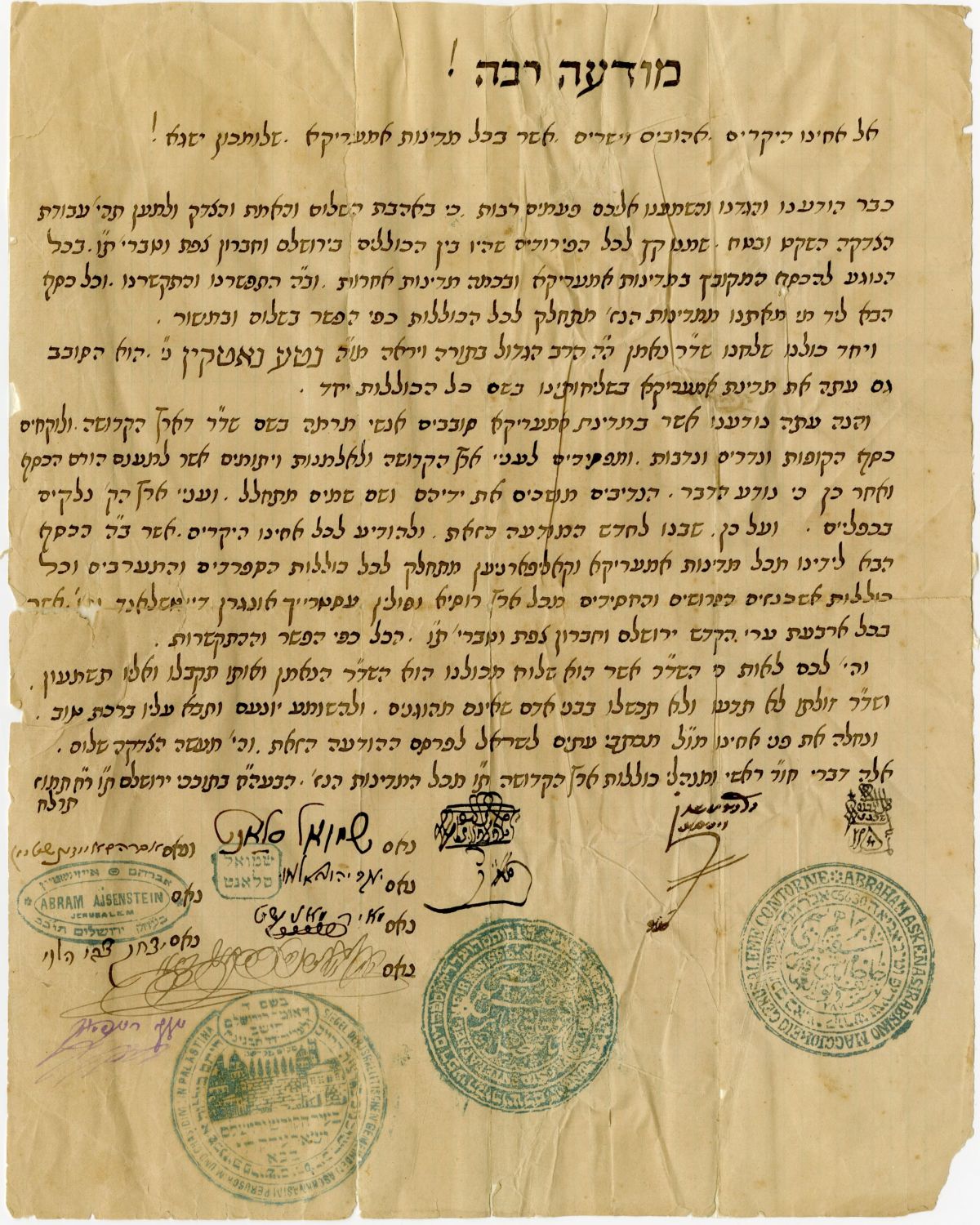
"To our dear brothers, beloved and honest, in all the countries of America, may you be well!" - an early and important emissary letter for the collection of funds in America for the benefit of Ashkenazim and Sephardim in the four holy cities - Jerusalem, Hebron, Safed and Tiberias. After people fraudulently collected money and presented themselves as Emissaries from the holy land in America, this letter was sent to strengthen the hands of emissary Rabbi Neta Natkin as the sole messenger of the Gedolei HaDor. The signatories are headed by the great Rabbi and leader of the Ashkenazi community in Jerusalem, the Gaon Rabbi Shmuel Salant, and the signatures of the Sephardic Gaonim (right) and Ashkenaz Gaonim (left) in Eretz Israel. Yerushalem, 1878. Handsome writing, and the signatures of the Gaonim.
This Emissary Letter was written after it was agreed to appoint emissary Rabbi Neta Natkin, son-in-law of Rabbi Yosef Zundel of Salant, as the sole and exclusive representative of the Ashkenazi Kollel, as well as for the Sephardic Kollel in the Holy Land, and the sole authority to collect money in America on behalf of the Kollels of the Holy Land with the consent of all the great rabbis, headed by the leader of the community, Rabbi Shmuel Salant. In 1878 it became known to the greatest rabbis in the Eretz Israel that there were some fraudsters in America who presented themselves as emissaries of the rabbis in Eretz Israel and collected money on behalf of the poor of the land and in fact took the alms for themselves, and this led to the fact that when this became known to the benefactors of America, they stopped supporting the Jews of Eretz Israel. This emissary letter was intended to strengthen the first validity given to Rabbi Neta Natkin as sole emissary, and to reawaken donations from American Jews to the Kollels in Eretz Israel after the damage caused by these fraudsters.
"And now we have learned that in the state of America there are impostors who pretend to be emissaries from Eretz Israel and take money from charity boxes and donations. And they cause losses to the poor of the Holy Land, as well as to the widows and orphans, for whom the money was raised, and after this it has become known, that the donors withdraw their support, and the name of G-d is desecrated. And the poor of the Holy Land are doubly affected. Therefore, we have returned to renew this advertisement to inform all our dear brothers who, thank G-d, that the money that comes into our hands from all the countries of America... is divided into all Sephardic and Western Kollel's and all Ashkenazim Prushim and Hasidim from all over the Land of Russia and Poland Austria Hungary Germany... everything according to the contract." and continue to strengthen the hands of the faithful emissary Rabbi Neta Natkin , "that no other emissary except him so that you will not be failed by people who are not trustworthy...".
[1] Leaf. 21x27 cm. Reinforced with adhesive glue on the back. Tears in the margins. Good Condition.

Philosophische Erzählungen - philosophical stories, by Theodor Herzl. Berlin 1900 - 1st edition. German.
17 stories written by Herzl from 1887 until his departure for Paris in 1892 as a correspondent for the Viennese newspaper "Neue Freie Presse" and after his return to Vienna in 1895. In the stories, Herzl expresses his attitude toward progress and technology, as well as his views on human suffering and morality, on the masses and individuals, on society and the state, on pleasure and duty, on the love of a man for a woman and parents for their children. Herzl's own casual environment and life experiences are usually the starting points of the stories, and they are a kind of mirror of Herzl's path first and foremost to himself, and then to the acknowledgement of human hardships in general and the plight of the Jews in particular, and from here he discusses the Jewish question in all its severity.
244, 8 pages. Original cover with gilt lettering. Stains on some pages, mostly in the margins. Light stains on the cover. Worn upper and lower part of the spine. Good Condition.
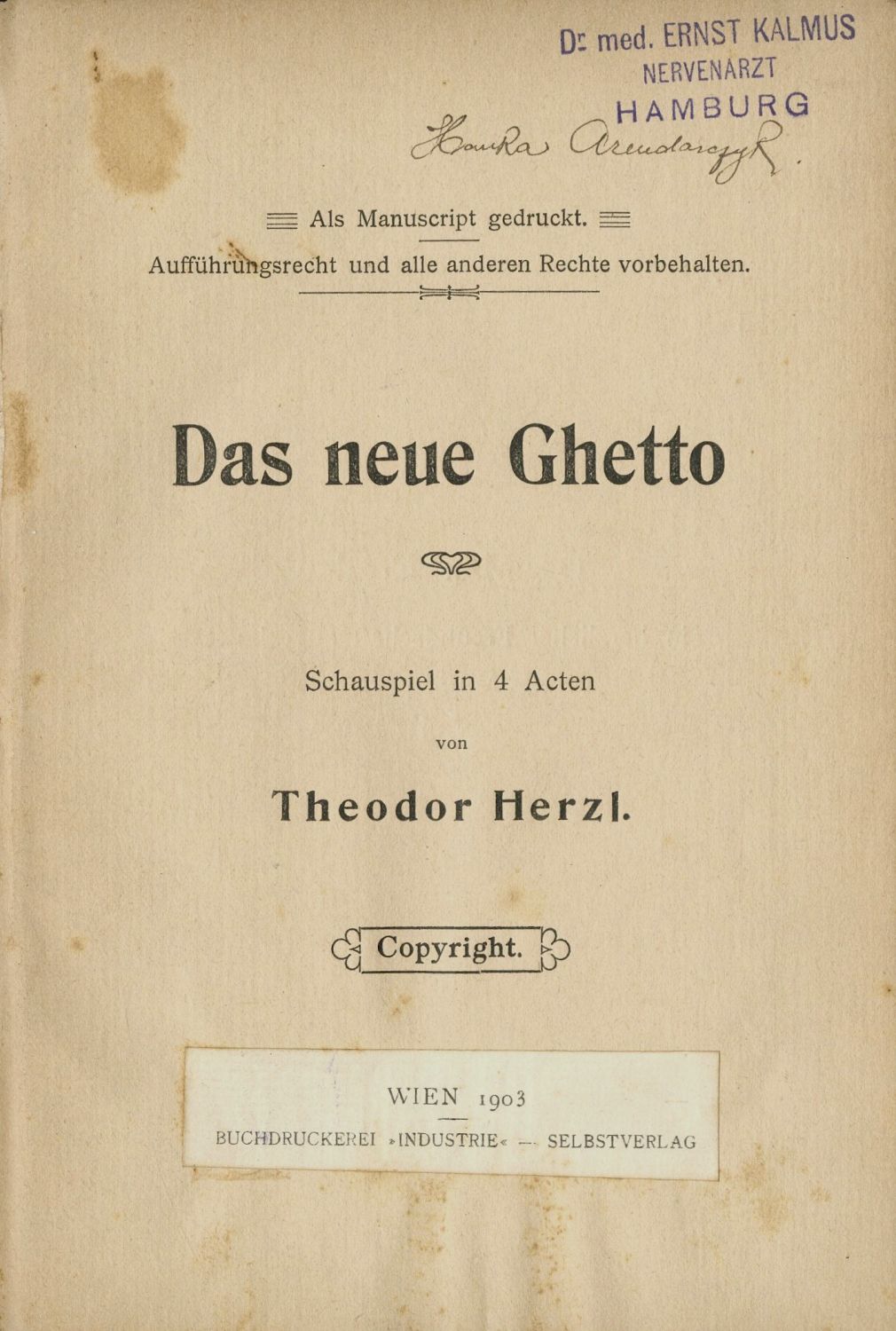
Das Neue Ghetto, Schauspiel in 4 Acten von Theodor Herzl. The New Ghetto by Theodor Herzl. Vienna, Self-published, 1903. German.
A four-act play. The play deals with an assimilated Jewish lawyer in 1893 Vienna, who tries to get out of the social ghetto imposed on Western Jews, but fails. At the end of the play, he died. His tragic death at the end of the play signaled to the Jews in the Diaspora that their current situation required immediate change. The play was written under the influence of the Dreyfus trial, which Herzl covered as a journalist, and the trial caused a change in Herzl's worldview and led him to the conclusion that the solution to the Jewish problem in the Diaspora would exist only if they were given an independent state of their own. The play was written in just 17 days, from October 21 to November 8, 1894. Fearing reactions to the play, Herzl wrote the play under the pseudonym ''Albert Schnabel''. Herzl dedicated the play to Dr. Max Nordau. Owner signature and ink stamp of Ernst Kalmus on the title page.
A sticker was affixed to the title page that read: WIEN 1903 BUCHDRUCKEREI ''INDUSTRIE'' SELBSTVERLAG - Vienna 1903 "INDUSTRIE" self-published book printing. Some say that the publisher may have used copies of the first edition in his possession, and added a sticker with the year 1903, indicating the year of distribution of this edition. Either way, before us a very early edition of ''The New Ghetto''.
[3], 100 p. 22 cm. Light stains. Old cardboard cover. Good Condition.
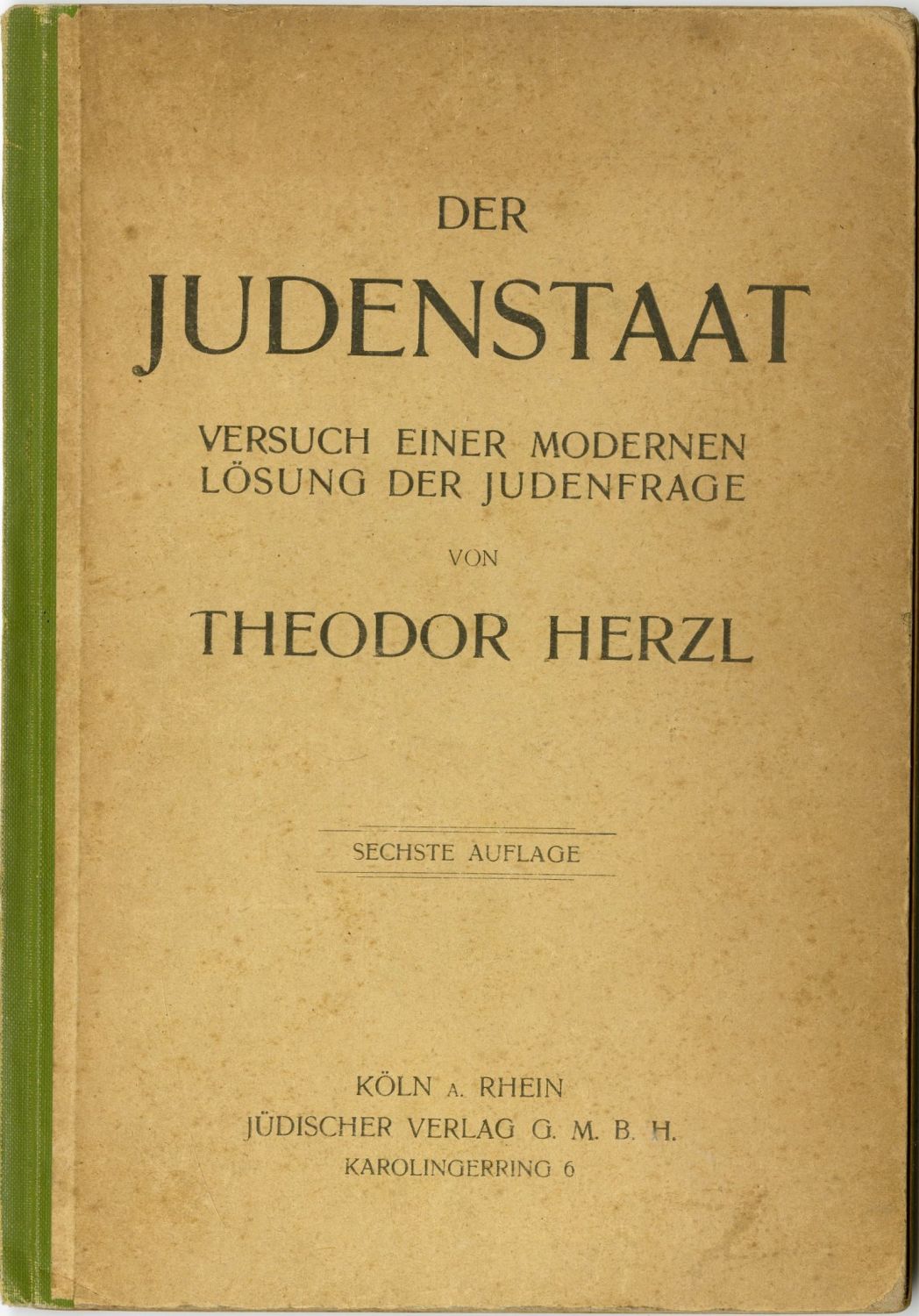
DER JUDENSTAAT VERSUCH EINER MODERNEN LOSUNG DER JUDENFRAGE VON THEODOR HERZL The Jewish State by Theodor Herzl, Published by Judischer Verlag, Cologne, 1908. German.
In 'The Jewish State' [Der Judenstaat], Herzl outlines his vision for the future Jewish state in great detail. Herzl outlined the structure of the future state, at a time when it was considered a distant dream among most Jews. The book was first published in Vienna and Leipzig by M. Breitenstein on February 14, 1896, under the subtitle: "An Attempt at a Modern Solution to the Jewish Problem", about a year and a half before the First Zionist Congress. About the way the book was written, Herzl wrote: "I don't remember writing anything in my life in such a state of elation, when I wrote this book.. When I wrote this book. I worked on it every day, until all my strength was exhausted." No reputable publisher wanted to publish the book, including Herzl's regular publishers, Donkner and Humboldt from Leipzig. The Cronbach publishing house in Berlin, which was owned by a Jew, also refused to publish it. Finally, Herzl was published by Max Breitenstein, an assimilated Jew and the owner of a small bookstore in Vienna. Breitenstein himself did not believe in the Zionist idea as a whole as well as in the commercial success of the book, and agreed to publish it against the background of his personal acquaintance with Herzl's close family circle. When it was published, most members of the public dismissed the ideas presented in it, and one of the editors of the Jewish newspapers even offered to donate his chariot to drive Herzl to the madhouse. Despite this, the ideas presented in the book began to gain momentum, and additional editions – in Yiddish, Russian, English, etc. – appeared shortly after the German edition, and within a short time it became the foundational book of the originators of the Zionist movement.
94 p. Original cardboard cover. Good Condition.
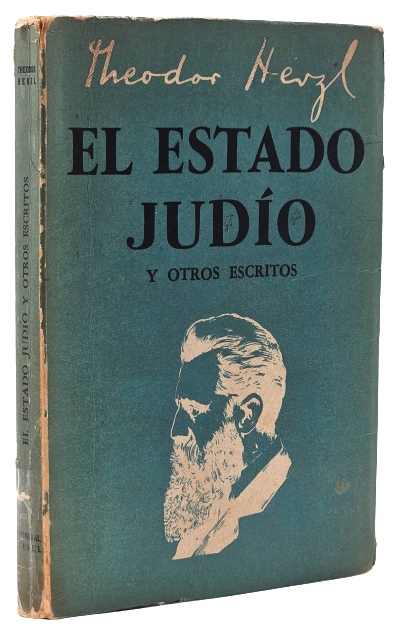
EL ESTADO JUDIO Y OTROS ESCRITOS - The Jewish State and other writings . Herzl's book "The Jewish State" (first published in 1896), in which Herzl expressed his vision for the Jewish state, in Spanish translation - a special edition with additional writings by Herzl translated into Spanish from the German original, Published by ISRAEL Buenos Aires, Argentina, 1960. Nice copy.
Special Spanish edition released to mark the 100th anniversary of Theodor Herzl's birth. This edition includes a lengthy introduction on Herzl's personality and his historical influence on the Zionist movement by Alex Bevin. It also included three speeches by Herzl that were translated into Spanish - the speech he gave at the Maccabees Club, Herzl's opening speech at the First Zionist Congress, and Herzl's speech at the Sixth Congress known as the Uganda Congress, in which the Uganda Plan was discussed - this was Herzl's last speech at the Congress, and the last of his life, (Herzl died about a year later), which he concluded by quoting from Psalm chapter 137: "אם אשכחך ירושלים תשכח ימיני".
216 [3] p. On the page next to the title page is a photograph of the first edition of "The Jewish State", and one page before is a picture of Herzl. Good Condition.
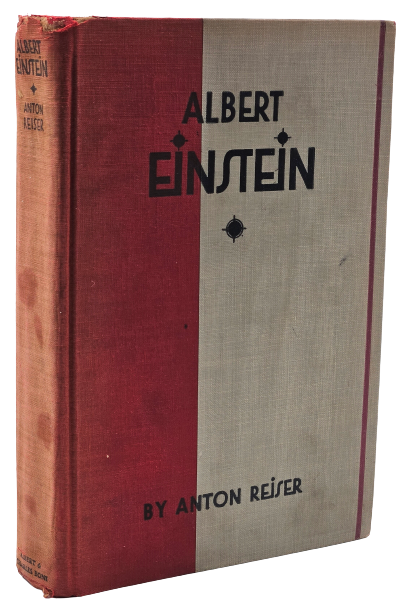
Albert Einstein: A Biographical Portrait, by Reiser Anton published by Albert & Charles Boni, New York, 1930 - First edition. English.
Biography of the life of Albert Einstein by Anton Reiser, pen name of Rudolf Kaiser - German historian and literary man, husband of Einstein's stepdaughter. One of the first biographies dealing with the life of the great scientist from a personal aspect, while he was still in Germany, to which Einstein himself gave his "consent". At the beginning of the book, Einstein writes about the author: " The author of this book is one who knows me intimately in my actions, thoughts, beliefs, slippers in the bedroom" and testifies that he read the book written about him: "I read it to satisfy my curiosity. What interested me was not the desire to know what I looked like, but a side view of how I looked. I found the facts of the book to be adequately accurate...".
Kaiser, gives for the first time an intimate account of the life of one of the greatest physicists who ever lived. The book is divided into six chapters: Childhood and youth, self-support, formulation of the theory of relativity, during and after World War I, Fame, and Einstein today. The book contains seven plates of photographs from different stages of Einstein's life, starting from his youth.
In the introduction, the author discusses one of the wonders of Einstein's personality - the incomprehensible gap between his humble personality and his own lifestyle and the worldwide fame and popularity he gained so early in his career following the breakthrough he brought to the world of science and physics. "His personality and global reputation are a miracle... With Einstein, almost nothing but humility is expressed" he writes. He states on the fact that Einstein did not see himself as a world-renowned "scientist" at all, and that his attitude toward science was the same as the artist's attitude toward his craft. He adds: "Einstein is undoubtedly the perfect man... There is no human and intellectual field that does not interest him. He is interested in all the values and happenings concerning the mind". The author describes the young Einstein as a shy and closed introvert, who most of the time preferred loneliness above the society, with a deep "religious" feeling, who was not really interested in school studies, and who only began to be interested in mathematics at the age of 13 following a book he received from his uncle. And already at the age of 14 he was considered a genius in mathematics and geometry. However, in those years Einstein was more interested in classical German music than in mathematics. All this until his breakthrough with his obtaining Swiss citizenship in 1901, when Einstein began working at the government patent office in Bern, the capital, as a third-rate technical expert. He then began studying the speed of light, and quickly became famous for four articles in the physics annual Annalen der Physik, the most important scientific journal of physics at the time. These articles are considered cornerstones of modern physics, which changed the accepted perceptions until then regarding the connections between space, time and material, and they brought Einstein his first fame in the world of science. However, the uniqueness of the biography before us is that it deals mainly with Einstein's personality and less with his scientific work, as the author explains at length at the beginning of the third chapter.
This biography was published in 1930, three years before Einstein was forced to flee Germany, due to Adolf Hitler's rise to power and new laws prohibiting Jews from holding official positions. Shortly after he escaped, Einstein's books were burned at the stake in the public burning of Jewish books by the Nazis, a reward of 5,000 Reichsmark was placed on his head, and the Nazi government stole his home and sailboat (pictured in the book). Rudolf Kaiser, the author, was also forced to leave Germany in 1935 because of his Jewish heritage.
225 p. Hardcover with the original cloth cover. Light stains on the last pages. Lightly faded spine. Condition Good.
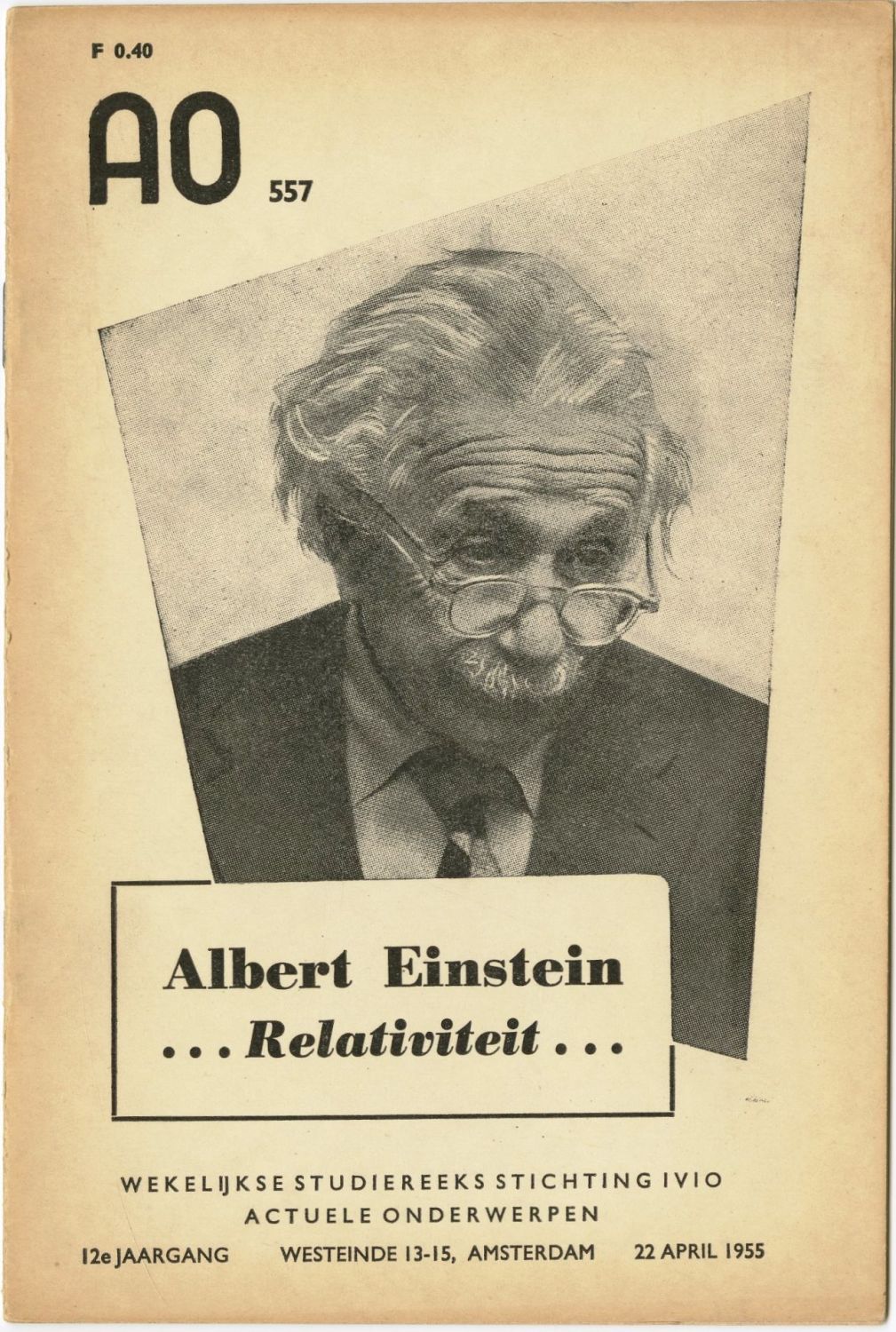
Albert Einstein... Relativiteit... - Albert Einstein... Theory of relativity. The Dutch AO Magazine, a special memorial booklet published four days after Albert Einstein's death, dealing entirely with Einstein the man and scientist. Amsterdam, April 22, 1955. Dutch.
"Albert Einstein The Genius of Physics" by mathematician and astronomer Dr. Willem Johannes Adriaan Schouten. "For a moment, the world holds its breath... One of the great ones left us. Albert Einstein died on April 18, 1955. Last Sunday, he was admitted to the hospital in Princeton, New Jersey... It is difficult to express the influence of this scholar on the thinking of our century...". An entire magazine dedicated to Albert Einstein, the man and scientist, and to his historical part in the chain of the world's greatest scientists, as the writer calls him "Newton's counterpart". The article deals with Einstein's breakthrough in physical science - the curve of light, and the theory of relativity, in his personal life - his parents and family, an extensive review of his childhood years, his special character ("although he was friendly and cheerful, he was always the lone scholar"), his political opinions and attitude to the war, his attitude towards his students and the manner in which he delivered his lectures, his escape from Germany and his arrival in America, and more. The author concludes: "Einstein's discoveries revolutionized the world of physics... Anyone who impartially examines his life's work will have to admit that Einstein is a genius of physics that few in the history of science can claim... A very great man is gone".
16 p. 18 cm. Very Good Condition .

Albert Einstein in his study room at his house at 112 Mercer Street in Princeton, New Jersey - photographed by the British photography agency Odhams - February 1944.
Albert Einstein is wearing a sweater and holding a pipe seconds before open a book. At that time, Einstein enrolled in studies at the Institute for Advanced Studies (IAS) in Princeton.
26x20 cm. light crack on the lower part of the photograph. Condition Good - Very Good.

“Australia in Palestine” - Australia in Palestine. Memories, illustrations and photographs of ANZAC soldiers (mounted infantry unit) in Eretz Israel. An impressive book in an album edition which was produced by the Australian soldiers who served in Eretz Israel during the First World War, and which was intended to be sent as a souvenir to their friends in Australia and abroad. Published by Agnus & Robertson, Sydney, 1919. The book includes many unique color photographs documenting the special atmosphere that surrounded the stay of the Australian soldiers in Palestine, by Frank Harley and a portrait of General Allenby at the beginning of the book, made by James McBey especially for the book. The copy before us is numbered and it was sent from the soldier Dodo to his relative James Dodo in England - with a dedication and his signature on the special sticker that was intended for the dedication of the Australian soldiers. At the same time, the publisher also released copies without the special sticker which were sold to the general public. Before us a rare copy of the soldiers themselves with the sticker and dedication of the aforementioned Australian soldier.
From the editors' words in the introduction: “Australia in Palestine is in no sense intended to provide a complete picture of the part of the Australians in the great campaign. This is simply a soldiers' book produced entirely by soldiers in the field, on active duty to send to their comrades in Australia and overseas…”. The book was printed on thick and fine paper, and alongside vivid descriptions of the Australian soldiers' lives in Erstz Israel, there are many photographs of landscapes and people in and around Jerusalem - among them historical photographs of the arrival of the Australian soldiers in the Land, colorful illustrations in lithographic style, maps of the Middle East and Eretz Israel (also appears A large open diagram documenting the deployment of the Australian soldiers in Rishon Lezion), many humorous illustrations documenting the encounter of the Australian soldiers with Middle Eastern culture, illustrations of Australian officers, and more.
The preparation of the book involved James McBey - the official British artist in Palestine, Captain Hodge Kinson - the British press officer who gave the publication some of his rare photographs, the cinematographer Jeeps who accompanied the Australian soldiers in the campaign, and the publicist Burton who helped edit the book.
The ANZAC Mounted Infantry Division (ANZAC - Australian and New Zealand Army Corps) was a military unit that was built during the First World War and consisted mainly of volunteers from Australia and New Zealand and was mainly based on mounted infantry. Among the Anzac units that fought on the front in Israel was the Mounted Infantry Division . Mounted foot were soldiers who fought as foot but moved to their destination on horses. The main activity of the division was in the campaign on Sinai and Israel during which more than 33,000 soldiers were sent who participated in major battles between 1916 and 1918 against the Turkish army. The force fought in the Gallipoli system and on the Western Front, but its mounted units also fought in the campaign on Sinai and Israel. In the famous Battle of Beer Sheva, Australian cavalry charged Ottoman positions while riding horses, capturing the town and its wells. This type of soldier, which was common before and during the First World War, began to decrease after the war when the army began to transport infantry on top of armored vehicles. The unit was disbanded in 1919.
During the Sinai and Palestine Campaign of World War I, Australian soldiers were known for their love of "smoko". Smoko was a break from fighting, usually lasting about 15 minutes, where soldiers would smoke cigarettes, eat, and relax. The term smoko is still used in Australia today to refer to a break from work.
153, [4] p. 28 cm. Very Good Condition.
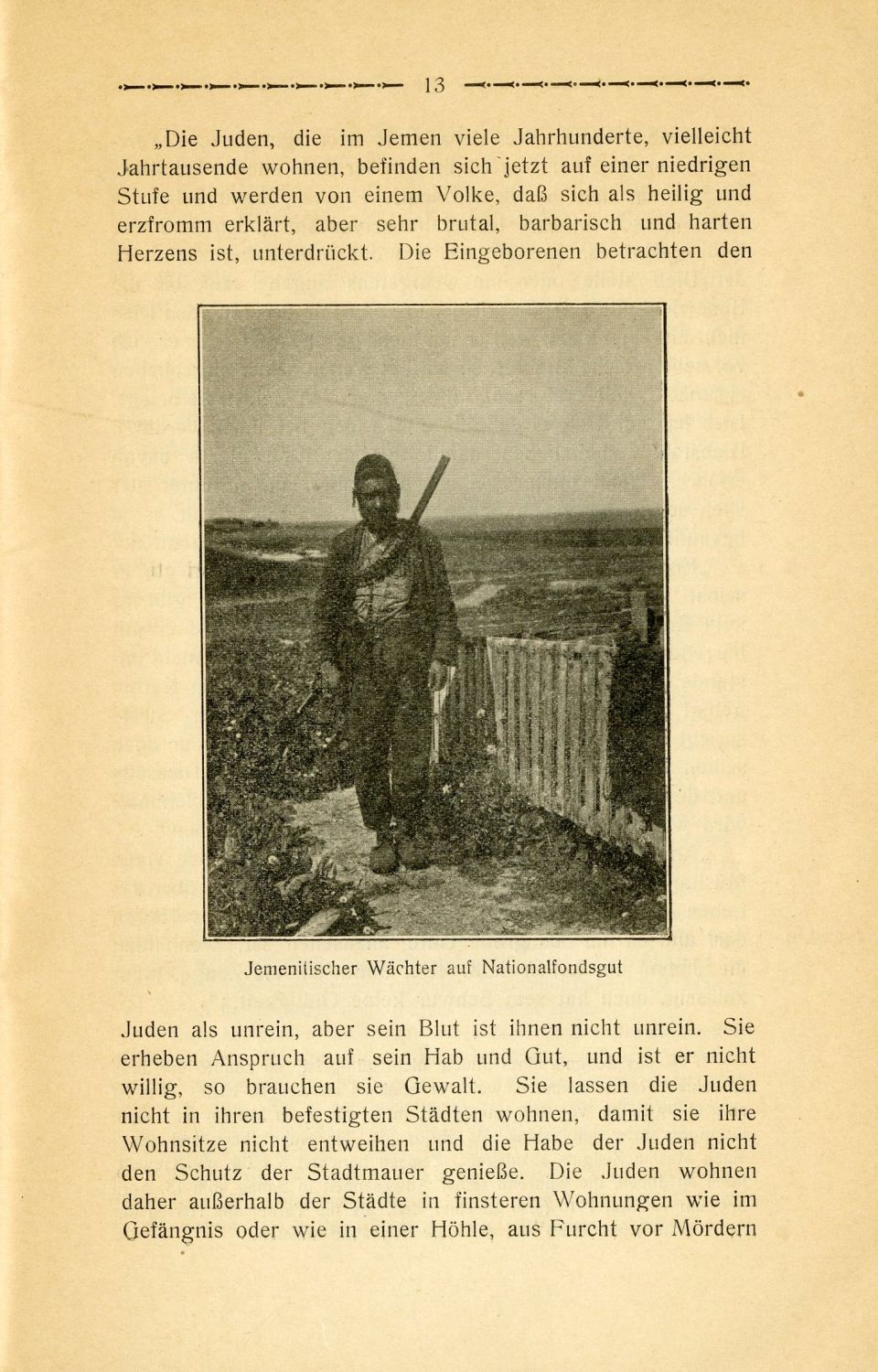
Die Jemenitischen Juden - Yemenite Jews, by Joshua Feldman, Judischen Nationalfonds Publishing. A rare publication about Yemenite Jews from the beginning of their settlement in Sana'a until the immigration of 300 Yemenite Jews to Eretz Israel in the first decade of the 20th century, is accompanied by photographs of Yemenite Jews during Aliyah to Eretz Israel and their settlement in the country's colonies. A vivid description of the situation of the Jewish communities in Yemen. Cologne, 1912. German.
The author toured Yemen in Jewish neighborhoods and communities at the beginning of the 20th century, and brings here his impressions of his journey. At the beginning of the booklet, the author deals with the situation of Yemenite Jews in the various cities in Yemen itself. The writer found a description written by a tourist who visited Yemen in the 19th century, indicating that in Sana'a's Yemenite community, which once numbered about 10,000 people, only 2700 Jews remain. He reported famine raging in Sana'a and harassment by their Arab neighbors. From the point of view of a European who tours the country, the writer describes the Yemenite community in Yemen as a whole, the various crafts in which the Yemenite Jews were engaged, and their humble nature:
"A European Jew can hardly imagine the humble nature of the Yemenite Jews... Anyone with money or valuables hides it in the ground or secret holes they have in their homes so no one will see it...", he writes. He also describes the extreme poverty in Yemenite homes: "When you enter a house, you see the poverty – lack of furniture, utensils, bedding, food, and clothing... How can the Jews endure this distress?"
Among other things, he tells of the restrictions imposed by the ruling Muslims of Yemen, and of the suffering of the Jews:
"If a Jew meets a Muslim on any level, he is obliged to salute him and address him as Lord. If he does not do this, he will be beaten mercilessly. It is forbidden for a Jew to ride a donkey, let alone a camel, the Jews are like slaves... Jews are forbidden to wear white, red or green clothing... Only on Shabbat or holidays, when Jews are only in their homes and there are no Muslims among them, do they also dress in white robes. The rich Jews must also look poor, lest they arouse envy and plunder. In the big cities there are sweat baths for Muslims. Jews are forbidden to enter there... A Jew is forbidden to bypass a Muslim on his right, a Jew is forbidden to wear socks..." He goes on to describe several cases in which Jews were beaten by Muslims, and how their sentences were biased in favor of the Muslims, and concludes:
"In short, the suffering of the Jews in Yemen cannot be described."
The writer describes how, as a result of all this, the Jews decided to leave Yemen and immigrate to Eretz Israel. In the first decade of the 20th century, a group of about 300 Yemenite Jews immigrated to Israel. They first settled in Jerusalem and Jaffa, and their living conditions began to improve. Later, some of them settled in Rishon LeZion and Rehovot. In the second part of the book, the author describes the integration of Yemenis into work in Eretz Israel, initiated by the Jewish National Fund, and the entry of Yemenite Jews as leading artists in the various departments of the Bezalel School of Art. Yemenite immigrants were devout. They were used to work and did not rely on donations from overseas emissaries. They suffered from housing and livelihood difficulties, but soon they managed to find a livelihood in agriculture in the Judea and Sharon colonies. They worked in the construction industry, agriculture, goldsmithing and more. He describes how Yemenite neighborhoods slowly began to establish themselves in almost all the colonies.
In the photographs in the booklet: Yemenite Jews arrive in Israel by ship, Yemenite Guard, Yemenite settlers on the shores of the Sea of Galilee, Yemenite shepherd in Ben Shemen, Yemenites in a filigree workshop in Ben Shemen, Yemenite boys working in fields in Hulda, Yemenite artisans in Ben Shemen, a Yemenite goldsmith, Yemenite Jews harvesting grain, Yemenite settlement in Merhavia, Yemenites in Degania cooperative estate, Yemenites in Bezalel School of Art, and more.
40 p. 23 cm. Very Good Condition.
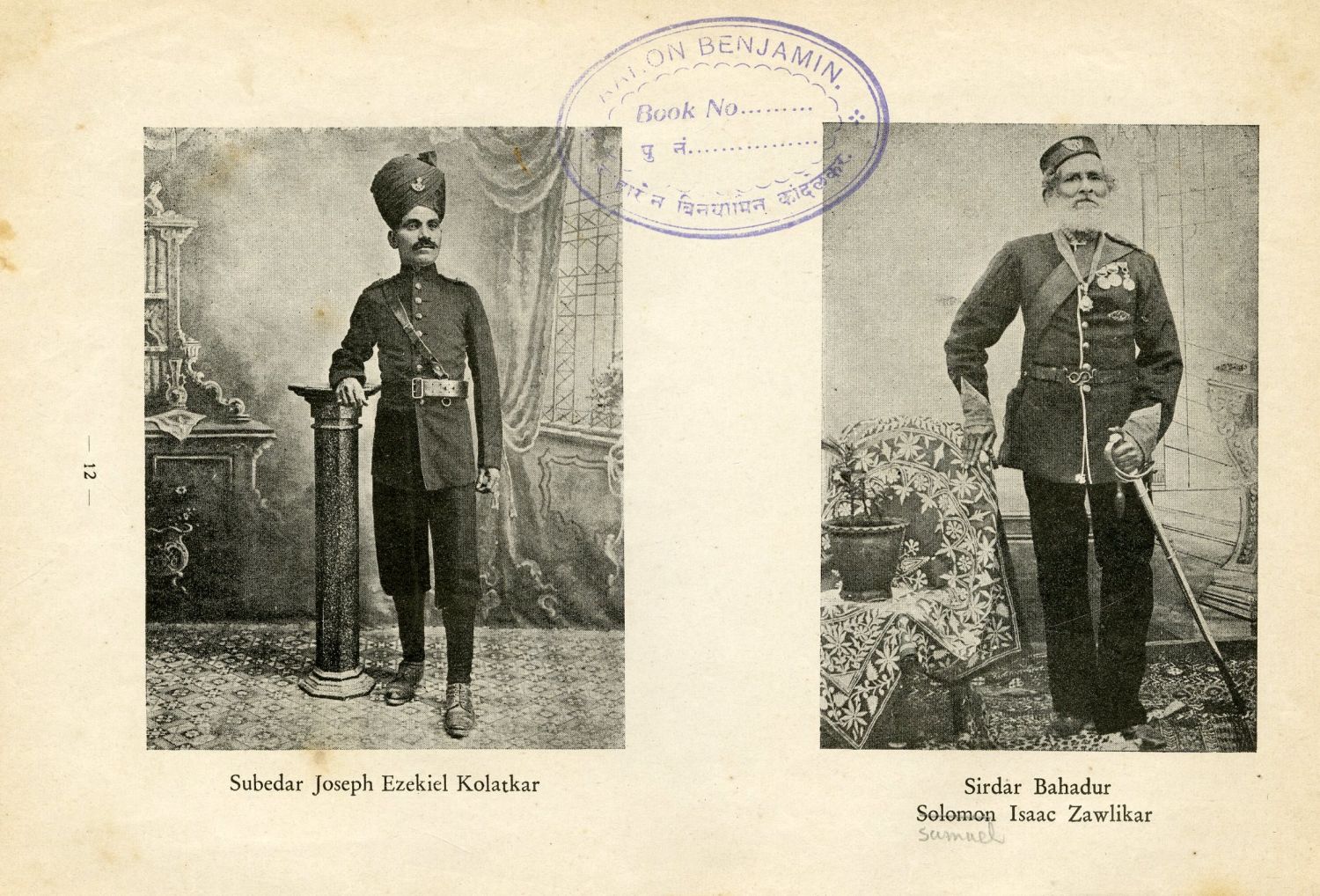
THE HISTORY OF THE BENE-ISRAEL OF INDIA - a comprehensive and unique publication about the "Bnei Israel" community in India, by Haeem Samuel Kehimkar - Dayag Publishing Tel Aviv, 1937 - only edition. English. Accompanied by rare photographs of the members of the Jewish community in India.
Important publication about the "Bnei Israel" community in India. In his book, the author, who was a very active and educational figure in the Bnei Israel community in India during the 19th century, reviews the history of the Jewish community in India, its origins, lifestyles, customs - the special wedding customs of the community, divorce (according to him, there is almost no known case of divorce in the Bnei Israel community in India), the special customs of circumcision in the Bombay Jewish community, the special mourning customs, the hierarchy of leadership, special customs related to the woman giving birth (among other things, a special custom is described, in which the woman and her son would bathe in a hot water bath twice a day for a week from birth, and that the woman's head was wrapped in a bandage during this entire time for protection from the evil eye, and more), the typical cuisine of Indian Jewry, the various arts practiced by the Jews, and more.
The author documents in his book notable Jews in the community, such as Yehezkel Benjamin, who published various holy books on his own, such as the Passover Haggadot, prayer books, and Jewish press, also Shalom Volvatkar who translated many books into the Marathi language, there is a special chapter on the many holy books printed in Marathi in the 19th century in Bombay, there is a list of benefactors who contributed to the community on a regular basis, the names of Jewish military officers who served as soldiers in India and their work, etc.
At the end of the book there are 28 pages with 51 photographs of important Jews from Indian communities - among them a photograph of the author, Rabbi Yosef Yehezkel Rajpurkar, Yosef Salomon Jiratkar Pune, Dr. Avraham Chaim Kaminkar, the principal of the "Elly Kadoorie" school Mrs. Rivka Reuven, the Indian Jewish playwright Joseph David Fluker, praying at Magen Avraham Synagogue during Lord Barborn's visit - in this photograph you can see women and men sitting separately in the same Azara (section), A Jewish bride in traditional clothes, a group photograph of the author and his family, a group photograph of Simchat Torah celebrants, a group of carpenters, a multi-participant photograph at the reception held for Dr. Emanuel Oswanger in 1936 in Bombay, the Baal Tokea sounding the shofar, a photograph of the interior of the Shaar HaShamayim synagogue - 1896, dignitaries and community leaders, and more.
Cover design: Indian Jews say "Shema Israel" in the face of a storm at sea and a sinking ship.
VII, 290, +28 photo plates. Some detached pages. worn and loose cover, glued paper reinforcements. Condition Moderate.
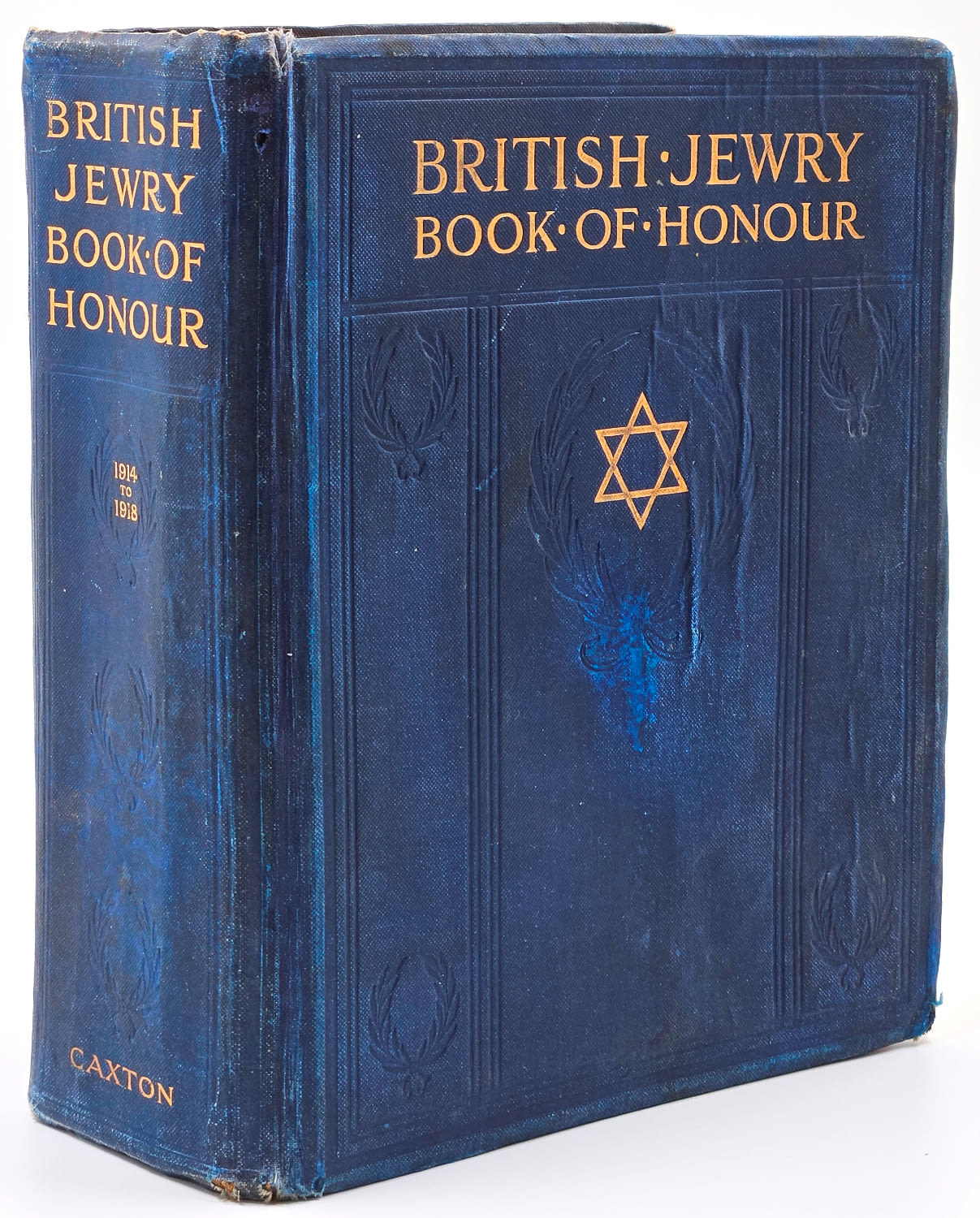
British Jewry Book of Honour - a huge work in honor of the Jewish soldiers who fought in the British armies during World War I, edited by Rabbi Michael Adler, the first Jewish chaplain in the British Army during World War I, and Max R. G. FREEMAN. Caxton Publishing Company - London, 1922 - limited edition of only 3000 copies published. This copy is numbered 1302. Signed by publisher H. Bloom. who added in his own handwriting on the protective page the memory of the Jewish fighting unit: "Eastern Rifles, German S.W. Africa 1914, 1st S. A. Infantry, 2nd Battalion, 1915-1919, B Co".
A rare work that was published in order to commemorate their memory and show the contribution of Jewish soldiers in the British war effort during World War I. A particularly thick book that includes in the first part the names of some 50,000 Jews - men and women who served in the various corps in the British army, and in the second part their pictures. The book describes in detail the process of recruiting Jews to the various units, the various roles played by Jews on the battlefield in the units, the Jews wounded or killed in battle, the work of the Jews in hospitals, and their contribution to other Jewish institutions and agencies. Using many classified, military, and public sources to which Rabbi Adler had direct access, he was able to present in the book a detailed alphabetical list of Jewish soldiers killed in the war, including their dates of death, Jewish soldiers who were awarded honors, and a names lists of Jews who served in the various corps. All are listed by service location and by battalion name.
Also listed are the names of Jewish soldiers with the highest decorations of excellence – five who won the prestigious "Victoria Cross", 49 soldiers who received the "Medal of Honor", 263 soldiers who won various Military Crosses, 329 soldiers who won military medals, and many more who won secondary prizes. Also in the book are letters of support and appreciation from various Jewish and non-Jewish dignitaries, noting the great contribution of Jewish soldiers to the British war effort. In the impressive historical work before us, Rabbi Adler intended to preserve the memory of the Jewish fighters for future generations for the Jewish people internally, and at the same time to present to Great Britain the contribution of the Jews and social solidarity towards the kingdom of which the Jews felt an inseparable part.
The second part of the book, which spans no less than 364 pages, contains photographs printed on thick high-quality paper, of more than 4,000 Jewish soldiers who served in British army corps during the war, of whom more than 2,000 were killed in the war. Among other things, there are photographs of memorials erected especially in their memory, various group photographs of Jewish soldiers in the various British units, prayer ceremonies of Jewish soldiers held during breaks in the battles, group photographs of Jewish women who practiced medicine during the war, Jewish soldiers who worked alongside the British in Palestine during the war, tombstones on the graves of fallen Jewish soldiers, Jewish soldiers celebrating the Passover Seder, Group photographs of Jewish soldiers in front of synagogues and in the synagogues, "military rabbis" and Jewish clerics who served in the various corps, and many more. (See a small portion of the attached photos.) One of the pages contains photographs of Joseph Trumpeldor, as well as photographs of the Palestine Regiment.
British Jewry, before, and during World War I, was a diverse community that actually consisted of a collection of communities.
In 1914, Jewish individuals and families in Britain spanned the entire social spectrum, with some fully integrated into British cultural life and others maintaining a distinctly Anglo-Jewish identity. This led to the fact that when the war broke out, the Jewish volunteers, and later the army recruits, became an inseparable part of the British forces themselves, and they were recruited to the various combat units according to their qualifications, and according to their places of settlement, regardless of their religious or ethnic identity. With the exception of a few Jewish-only battalions of the Royal Fusiliers formed in 1917, known as the Jewish Legion.
The editor of the book, Rabbi Michael Adler, was the first Jewish chaplain in the British Army during World War I, and has a place of honor in assisting Jewish soldiers during the war through a wide variety of channels. When World War I broke out in July 1914, Rabbi Adler realized that his religious skills were needed at the front. He wrote to the War Office asking to be drafted as a chaplain, but was refused. Rabbi Adler ignored the refusal and, without waiting for an official appointment, immediately took action. In the first month of the war, he distributed an shortened Siddur for the use of the soldiers. After some time, when he again applied to the War Office, he received the official appointment. Rabbi Adler, like the other chaplains in the British army, walked around in uniform with a collar as a white clergyman. The chief chaplain was a bishop, and he suggested that he wear a large Star of David necklace so that the soldiers would recognize him as a Jew, an Idea which Rabbi Adler embraced. He aspired to help every Jewish soldier. As Rosh Hashanah and Yom Kippur approached, he received permission from the commanders to release the Jewish soldiers from the fighting for a few hours. He did the same before major battles, understanding that a moment of communion and prayer before battle could be meaningful to them. Rabbi Adler helped the soldiers as best he could: he visited wounded soldiers, received permission to mark the graves of Jewish soldiers with a Star of David, traveled far and wide to conduct burial ceremonies, and wrote a guide to Jewish burial for Christian clergy. Rabbi Adler completed his service in July 1918. He received a medal for his service and returned to his post as head of the congregation of the Central Synagogue in London. In finding the many names of the Jewish soldiers that appear in the book, Rabbi Adler used, among other things, the records of the Jewish Chronicle, which from the beginning of the war published on a weekly basis the names of the Jewish soldiers killed in the war.
Rare. Only two entries in the World Cat Library catalogue in London libraries.
XIX, 636 pages of text + 364 pages of photographs. Hardcover, Original, Covered in fabric with gilded letters. Gilt engraved top page edges. Light color peels on cover. Stains on some pages of the book - mainly on the first pages. Overall Condition Good.

RESOLUTION adopted by the Central Conference of American Rabbis at chicago ill, july 4th, 1918 - The official response of the Union of Reform Rabbis in the USA to the Balfour Declaration.
A printed leaf of the official response of the Union Reform Rabbis in the United States to the Balfour Declaration, who are fundamentally opposed to the spirit of the declaration. It was published about seven months after the signing of the Balfour Declaration. The rabbis are grateful for the good will arising from the declaration, but express reservations about the clause stating that the Land of Israel is The homeland of the Jewish people. Jews, like all other religions, have the right to live equally in any country in the world, and they should not be treated as having more ties to one land than to another. And they write explicitly: "We oppose the idea that Palestine should be considered the homeland of the Jews", adding that the Jews in America are part of the American nation, and that "the ideal of the Jew is not the establishment of a Jewish state", and that the destiny of the Jewish people is to "witness to G-d" in all parts of the world.
The statement is signed in print by Edward N. Calisch the chairman and 18 other rabbis, and also was sent to the British cabinet.
The Central Conference of American Rabbis (The CCAR) was founded in 1889, and is the largest and oldest organization of Reform rabbis in the USA. The position presented in the document before us characterized the position of the Reform movement in its "classic" period [1870-1918], which adopted the concept of universal mission, and in light of This was opposed to the Zionist movement. In the years between the two world wars, the position of the Reform movement towards Zionism changed. The change resulted from broad developments within the Reform movement and outside it, and was first and foremost related to inner review conducted by a new generation of Reform leaders in the movement and its goals.
In the United States, Zionism, as an ideology, has been more widely accepted, primarily due to the influence of Supreme Court Justice Louis Brandeis, a Reform Jew, who presented Zionism as a proud Jewish component within the framework of American Jewish patriotism. Moreover, the movement could not oppose the vision of a Jewish state, which over the years became increasingly closer to reality, to the point where it became an existing fact.
[1] leaf (printed on one side), 21.5 cm. Light tears in the margins. Condition Good.

Programma van den BUITENGEWWONEN DIENST TE HOUDEN ... HARE MAJESTEIT KONINGIN WILHELMINA VAN HARE MAJESTEIT KONINGIN WILHELMINA MET Z.H. HERTOG HENDRIK VAN MECKLENBURG-SCHWERIN - Special prayer order for the success of the marriage of Wilhelmina Queen of the Netherlands with the Duke of Mecklenburg-Schwerin, February 9, 1901.
Mizmor LeToda, Lecha Hashem Ribon HaOlamin - Special prayer for the success of the Queen's marriage which took place two days earlier: "לך ה'... אשר תשגיח בחסד וברחמים... עלי יום חתנת ושמחת לב גברתנו המלכה ווילהעלמינא יר"ה [ירום הודה]... וחלינו פניך להיות לה ולאישה השר המרומם... יהיו כעץ שתול על פלגי מים אשר פריו יתן בעתו... בימיה תושע יהודה וישראל ישכון לבטח, ישב איש תחת גפנו ותחת תאנתו...". and continues - LeShlomo El-kim Mishpatecha, HaNoten Teshua LeMelachim, and Hallelu E-l BeKodsho.
Wilhelmina Queen of the Netherlands, was the most popular and beloved queen in the Dutch monarchy. She was a passionate supporter of the Jewish community, and many Jews from all Israel communities participated in her wedding (over 300,000 people in total stood on the streets of The Hague to watch the procession). Especially notable was the story of the Jewish gentleman David Cohen, who was invited to participate in the private reception held at the royal palace on the wedding day. The queen approached him and surprised him when she began speaking to him fluently in Hebrew. Cohen later wrote that it was one of the most memorable moments of his life! Throughout her reign, Queen Wilhelmina supported the Jewish community, appointing Jews to high-ranking positions in her government and even spoke out against anti-Semitism on numerous occasions, she also provided assistance to Jews, especially during the Nazi occupation in World War II. During her wedding year, Wilhelmina established the "Queen Wilhelmina Fund" dedicated to providing financial aid to needy Jews - a historic extraordinary initiative among European monarchs.
7 pages. 23 cm. light stain in the upper corner of the booklet pages. Good Condition.

ORDE VAN DEN DIENST BIJ DEN DANK - EN BIDSTOND ter gelegenheid van het voorgenomen Huwelijk van H.K.H. PRINSES JULIANA met Z.H. PRINS BERNHARD VAN LIPPE - BIESTERFELD - A special prayer booklet in honor of the intended marriage of Princess Juliana (the only daughter of Wilhelmina Queen of the Netherlands) with Prince Bernhard. Amsterdam, January 6, 1937. On the cover is a photograph of Princess Juliana and her husband Bernhard. Hebrew and Dutch page by page.
Mizmor L'Toda, Lamenateach, Drasha (title), Mizmor Shir Chanukat HaBayit, Ma Ashiv, A special prayer composed especially for the occasion, and a long prayer for the success of the marriage, HaNoten Tshuah, Aleynu L'shabeach, Shir HaMa'alot, Halelu.
The most historically memorable event from Queen Juliana's wedding is precisely the absence of the Jewish community from participating in the wedding ceremony. The reason was the rise of anti-Semitism in the Netherlands. In the months leading up to the wedding, there were several anti-Semitic incidents in the Netherlands. Jewish businesses were confiscated, Jewish homes were vandalized and Jews were attacked in the streets. Because the heads of the Jewish community for their part were afraid of what might happen if they attended the wedding, and therefore preferred not to attend, and in fact no Jews appeared as part of the audience. In addition, they did not even receive an official invitation to come and participate in the wedding, which proved to them that the royal house itself did not want them to come. The absence of the Jewish community for its part was a powerful statement of protest against the rising anti-Semitism in Europe. For example, the New York Times newspaper, which covered the wedding event, reported: "The wedding of Princess Juliana of the Netherlands and Prince Bernhard of Lippe-Biesterfeld was magnificent, with the participation of royalty and dignitaries from all over the world. However, there was one conspicuous absence: the Jewish community of the Netherlands. The reason for the absence of the Jewish community was simple: they were not welcome." However, the Jewish communities inside expressed their participation in the historical event through prayer booklet of this type in which the Jews expressed their historical admiration for the Dutch royal house.
extremely rare. Only one copy is registered in the world library catalog world cat.
A rare video documenting the marriage ceremony of Princess Juliana without the participation of Jews see here
12 p. 24 cm. Good condition.
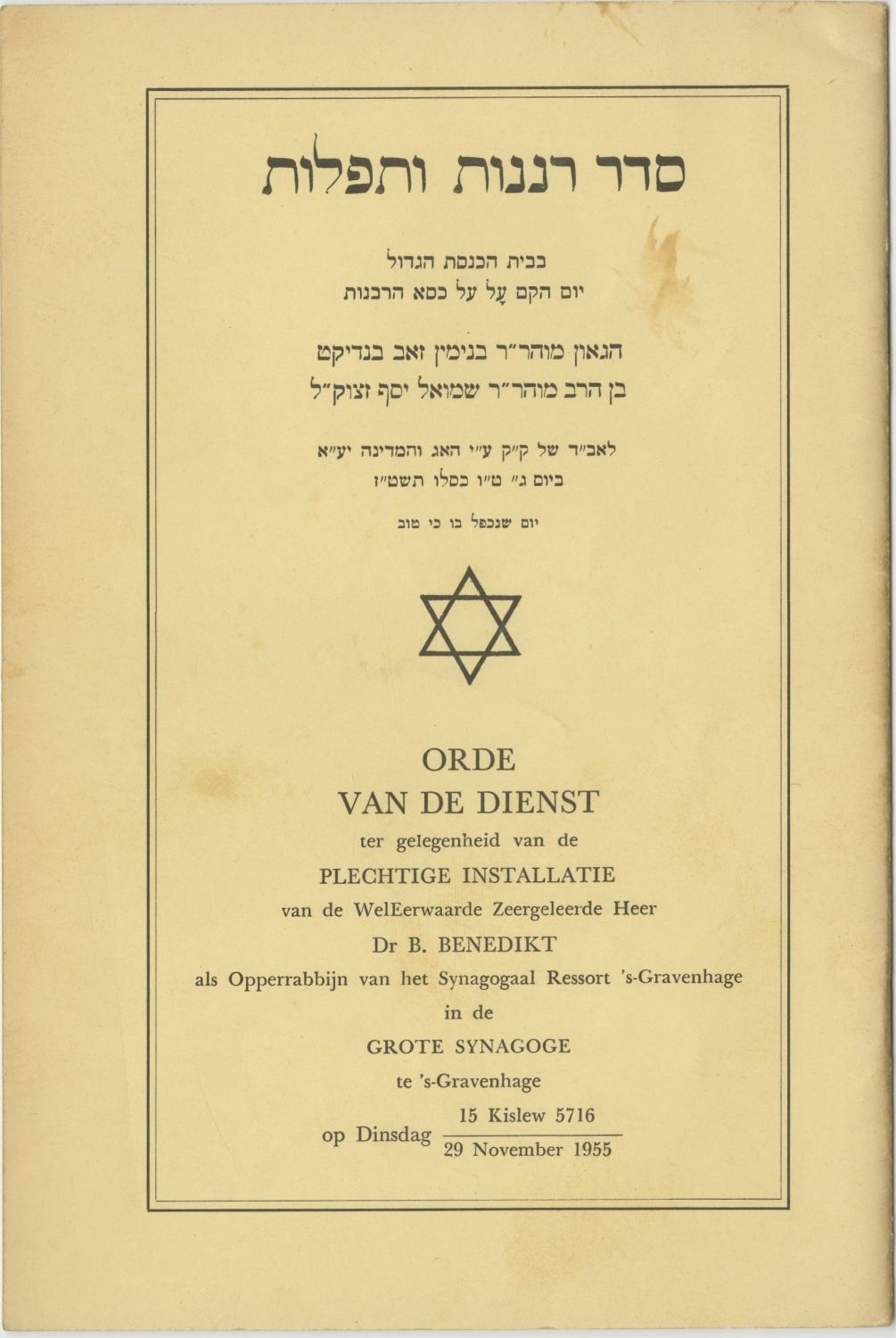
Order of praise and Prayers in the Great Synagogue on the appointed the Gaon Mohara"r Binyamin Ze'ev Benedict son of Rabbi Mohara"r Shmuel Yosef Zatzuk"l, to Av Beit Din o f Kehilat Kodesh of great Hague, on Tuesday, 15 Kislev, November 29, 1955. Hebrew and Dutch page by page.
A special prayer booklet issued on the occasion of Rabbi Binyamin Ze'ev Benedict's appointment to Av Beit Din Kehilat Hague in Kislev 1955. LeDavid Mizmor, a special song was composed on the occasion of the festive event: "Peace be upon you, the chosen of our congregations, with your coming to manage the members of our community...", Mizmor LeToda, Who Gives Salvation to Kings prayer for Queen Juliana, a special text for the prayer for the peace of the State of Israel, including a prayer for the gathering of the exiled, Yigdal E-l Hai.
In the summer of 1953, Rabbi Benedict went on a five-week mission in the Netherlands. During his stay in the Netherlands, the position of Dayan became available in Amsterdam, he often gave lessons and then became Rabbi of The Hague. At the top of his achievements in The Hague was his success in significantly improving the kosher slaughter system. In 1957, through the efforts of Rabbi Yehoshua Hutner, Rabbi Benedict was appointed by the Chief Rabbis of Israel as Rabbi of the Ahuza neighborhood in Haifa, serving as the rabbi of the neighborhood for 45 years until his passing.
13 p. 23 cm. Light stain on the cover. Condition very good.
Created and Develop with 🤍By webe ©2024